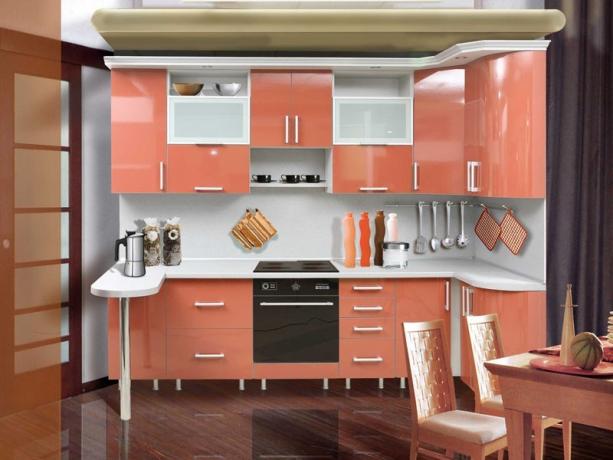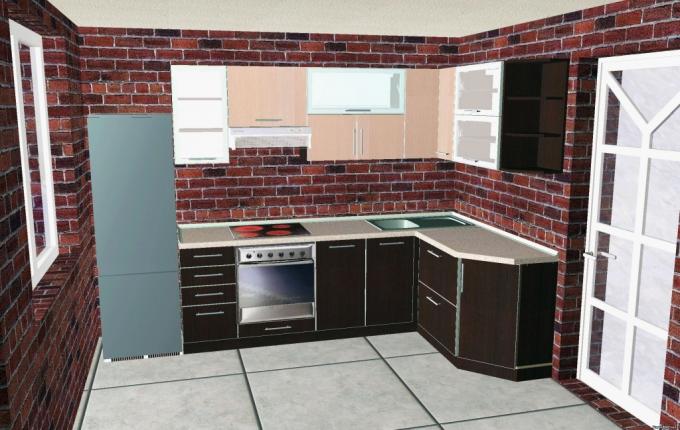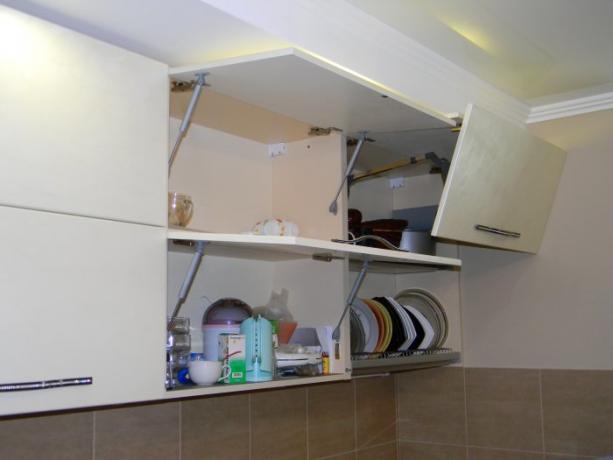Content
-
1 Factory or homemade - which is better
- 1.1 Postforming
- 1.2 Painted MDF
- 1.3 Laminated MDF
- 2 What you can do yourself or order a master
- 3 Conclusion
The appearance of the kitchen furniture creates its facade. The facades for the kitchen from the manufacturer are able to transform your headset and the kitchen as a whole, but there is no point in changing the shelves and boxes that are intact and working.
Many furniture craftsmen realized this long ago, and they only produce boxes and boxes, they buy facades from large firms, because the production of kitchen facades requires modern equipment and a staff of specialists, which the workshop cannot afford condition.

Modern kitchen facade in MDF.
Factory or homemade - which is better

The production of kitchen facades has reached impressive proportions.
There is no definite answer to this question. It all depends on the materials you prefer. If you need solid wood kitchen facade or a framed facade, then you may well find one in the workshop. But if you like modern materials, then it is better to immediately go to a furniture store, since in a workshop you can only resell a factory product.
Kitchen facades from the manufacturer are often distinguished by high quality and low price, since the production of these products is put on stream. However, there is also a problem here - store markups and transportation costs, so that in the end there is no big difference in cost.
Postforming

Production: postforming kitchen facades.
The material is quite young and fashionable today. In fact, this is a chipboard or fiberboard covered with laminated plastic so that the free overhang of the plastic is wrapped around the ends of the board and covers it completely. The transition between the front and end parts is smooth, and the coating is airtight.

In the photo there is a postforming furniture facade for the kitchen.
Such material can only be produced in a large-scale production with modern machine tools and a staff of specialists capable of servicing machines and managing complex production processes.
Postforming has the following properties:
- High resistance to aggressive chemicals;
- Durability;
- Wear resistance;
- Glossy surface;
- Strength;
- Practicality;
- Easy care;
- High resistance to solar radiation;
- High resistance to moisture;
- Lack of chemical, electrochemical and biological corrosion;
- Good tolerance to high temperatures and sudden changes in climatic indicators;
- Comparative cheapness in relation to painted MDF and solid wood;
- Low restoration potential;
- It is not possible to cover complex volumetric milling with postforming, the facades are made flat;
- Does not absorb odors;
- Does not fade over time;
- There is no way to repaint;
- Does not absorb liquids, oils, grease and other substances;
- Allows you to create curved and curved surfaces.
As you can see from the list, postforming is the most practical coverage option.
Important!
Postforming is perfect for those who pay less attention to all kinds of emotions about naturalness and environmental friendliness, and more follows considerations of functionality, convenience and durability cover. Naturally, there is no homemade postforming.
Painted MDF

Furniture made of painted MDF looks like postforming.
The production of facades for kitchens from MDF has long been mainstream. This can be easily explained: MDF is cheaper than solid wood, but it has almost the same performance characteristics.
These slabs are made from fibers of coniferous trees without the use of toxic chemicals. In terms of purity, MDF can be compared to the wood from which it is produced. Also, MDF is devoid of flaws common for wood: knots, cracks, parasites, etc.
Painted MDF is quite expensive, since the painting process is complicated. The paint is applied in layers, with each subsequent layer applied after the previous one has dried. It takes a lot of time, effort and money. At the end, the coating is polished or left matt, varnish is applied.
Painted MDF has the following qualities:
- Not afraid of water vapor;
- Resistant to moisture;
- Possesses high mechanical strength;
- Has a good restoration potential: the coating can be tinted and varnished;
- Has a good look;
- Under the influence of solar radiation, it gradually fades;
- Visible finger and hand prints remain on the surface;
- If moisture gets under the paint or in places where it is not, the plate may swell;
- Chips and scratches are possible;
- Requires care.
It is very difficult to produce high-end painted MDF on your own. This will require primers, paints, airbrushes and spray guns, drying rooms, etc. IN workshop it is, in principle, possible, but the vast majority of carpenters-furniture makers prefer to buy finished plate.
Advice!
If you decide to order the facade to the master, it is better to buy the material yourself.
The workshop buys the cheapest raw materials, the quality of which may not satisfy you, and if you purchase it yourself, you can control the composition of your future furniture.
Laminated MDF

Laminated MDF is like wood.
This material is produced by covering MDF boards with melamine or PVC foil. It will not work to make such a coating with your own hands; equipment is also needed here.
A decorative layer is placed under the film, it can be veneer or paper, furniture foil with a printed pattern is also used.
Characteristics of laminated MDF:
- Resistant to moisture;
- Doesn't require laborious maintenance;
- Withstands solar radiation well;
- Not afraid of aggressive detergents;
- Wear-resistant;
- The damaged film is practically not restored;
- Afraid of high temperatures (at temperatures above 70 ° C, peeling and swelling of the film is possible);
- It is relatively cheap;
- Durable enough;
- Does not absorb liquids, oils and fats;
- Does not absorb odors;
- If moisture gets under the film, the slab may swell.
As you can see, this is a budget coverage option that has good characteristics for its price.
Important!
Don't think that cheap is necessarily bad.
Often the price reduction is due to objective reasons: the use of more efficient technologies, common materials and inexpensive means of production.
What you can do yourself or order a master

Frame facade.
You can make it yourself kitchen frame facade or an array facade. To make the first one, no special skills are required, it is enough to buy consumables for the frame and the panel. Next, the necessary parts are cut, and the facade is assembled. Detailed instructions for making frame furniture are not a problem: there are a lot of them on the net.
For making a kitchen facade more energy and knowledge will be required from the array, but this is quite doable. You can also order such a facade in the workshop.
Advice!
Before making your own, watch the training videos, this will help to avoid common mistakes.
Conclusion
Independent production or manufacturing of kitchen facades by small workshops and workshops today becomes impractical, especially when working with modern materials.
At the same time, the classic production of wood may be more profitable precisely within the workshop or on your own. Nevertheless, it will be faster, more reliable and cheaper to buy ready-made facades, and do the rest to order yourself or use old furniture.


